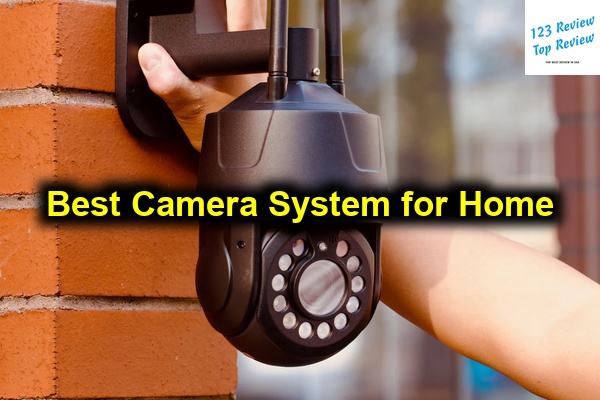From safeguarding your property to ensuring the safety of loved ones, a well-chosen camera system can provide invaluable peace of mind.

In this article, 123 Review covers everything you need to know to choose the best camera system for your needs, ranging from types and features to installation and brand recommendations.
Types of Home Camera Systems
Choosing the right type of camera is the first step in ensuring comprehensive home security. Each type offers distinct benefits suited to different needs.
Indoor Security Cameras
Indoor security cameras are vital for monitoring the interior spaces of your home. These cameras are designed to be discreet yet powerful, often featuring high-definition video, two-way audio for communication, and motion detection capabilities. They are perfect for watching over children, pets, or ensuring that everything is secure when you’re away.
Key features to look for in indoor cameras include:
- Resolution: Aim for at least 1080p to ensure sharp video quality, enabling you to see details clearly.
- Field of View: A wider field of view can cover more of a room, requiring fewer cameras to monitor large areas.
- Audio Features: Two-way audio functionality allows you to communicate with family members or even deter unwelcome visitors.
Outdoor Security Cameras
Outdoor security cameras are your first line of defense against potential intruders. Built to resist weather conditions like rain, snow, and extreme temperatures, these cameras are essential for monitoring entry points such as doors, windows, and driveways.
Key considerations for outdoor cameras include:
- Weather Resistance: Look for IP65 or higher ratings to ensure durability against elements.
- Night Vision: Essential for capturing clear video in low-light or nighttime settings.
- Motion-Activated Lights: Some models include floodlights or spotlights that activate upon motion detection, adding visibility and deterring unwanted visitors.
Wireless Security Cameras
Wireless security cameras offer incredible flexibility. They are easy to install as they don’t require physical wiring to operate. These cameras can be placed virtually anywhere within your Wi-Fi range and are usually powered by batteries, solar panels, or electrical outlets.
Advantages of wireless systems include:
- Easy Installation: Simply mount the camera and connect it to your Wi-Fi network via a smartphone app.
- Portability: Wireless units can be moved and adjusted with ease.
- Battery Options: Some models have extended battery life or come with solar charging capabilities.
Wired Security Cameras
Wired security cameras are known for offering consistently reliable connections and video quality, making them ideal for permanent installations where uninterrupted performance is crucial.
Important features of wired cameras include:
- Stable Connection: Because they are hardwired, they’re less subject to interference than wireless models, providing a continuous feed.
- Power Supply: Direct power means no need for battery replacements.
- Long-term Investment: While installation is often more complex, the stability and reliability of the connection make it worthwhile.
Floodlight Cameras
Floodlight cameras integrate security cameras with powerful lights that activate when motion is detected. This added illumination not only captures clear video but also serves as a deterrent to potential intruders.
Considerations for floodlight cameras include:
- Lighting Power: Look for lumens between 1000 to 3000 to provide bright, ample lighting.
- Motion Detection Sensitivity: Adjustable sensitivity can help prevent false alarms from trees or pets.
- Field of Vision: Wide-angle lenses are more effective at covering larger areas around your home.
Key Features to Consider
Once you’ve chosen the type of camera, evaluating essential features will help ensure you get the most from your system.
Video Resolution
The clarity of your video footage hinges on resolution. Higher resolutions like 2K or 4K provide detailed images and can be paramount in identifying important visual cues such as license plates or facial features. While 1080p is the norm, moving up to higher resolutions can be beneficial if storage and bandwidth are not limiting factors.
Night Vision Capabilities
Effective night vision is critical for 24/7 surveillance, especially for outdoor cameras. Look for systems equipped with infrared LEDs or advanced technology like color night vision, which provides more vivid images in low-light conditions. The range of night vision can vary, with distances typically between 30 to 100 feet.
Storage Options
Understanding your storage options helps manage how video data is saved and accessed:
- Cloud Storage: Offers easy access to footage from anywhere but often requires a subscription. It usually comes with secure servers and remote viewing.
- Local Storage: Involves saving footage directly to SD cards or DVRs, which can be more private and free of recurring fees but might offer limited space.
- Hybrid Solutions: Some systems offer both, providing flexibility in how you manage recordings.
Smart Home Integration
Smart home integration allows your security system to work seamlessly with other devices. Look for compatibility with platforms like Amazon Alexa, Google Assistant, or Apple HomeKit. This can enable convenient voice controls or trigger routines — for example, turning on smart lights when motion is detected.
Motion Detection Technology
Advanced motion detection reduces false alarms by differentiating between humans, animals, and vehicles. Some systems allow you to set custom zones or filters to focus on specific areas, improving both accuracy and relevancy of alerts you receive.
Recommended Camera Systems
Here are recommendations across different needs and budgets, providing a starting point for making your choice.
Best Indoor Camera Systems
- Nest Cam Indoor: Features high-quality video with robust integration into Google’s ecosystem. It offers clear audio, and seamless two-way communication features make it a great choice.
- Arlo Pro 4: Known for its excellent video quality and wireless flexibility, this camera system is ideal for smart homes thanks to compatibility with a wide range of smart platforms.
Best Outdoor Camera Systems
- Ring Floodlight Cam: A leader in outdoor security, combining HD video with powerful floodlights and a siren. Easily integrates with Ring’s broader ecosystem, providing comprehensive security solutions.
- Eufy Security SoloCam: Offers versatile and reliable outdoor monitoring without subscription fees, featuring a robust build and excellent video clarity.
Best Budget-Friendly Camera Systems
- Wyze Cam v3: This camera provides features usually seen in higher-priced models, such as color night vision and motion tagging, making it a great value.
- Blink Outdoor: Affordable and easy to use, offering basic outdoor security with good performance and extended battery life.
Best No-Subscription Camera Systems
- EufyCam 2: Provides excellent video quality and built-in local storage, making it perfect for those who want a robust system without monthly fees.
- Reolink Argus 3 Pro: A compelling option that combines great features with local storage and solar battery support to keep costs low.
Best High-End Camera Systems
- Arlo Ultra 2: Delivers 4K video resolution and an integrated spotlight, offering superior image quality and coverage — perfect for those looking for the best in class.
- Nest Cam IQ Outdoor: Features include facial recognition and a robust build, offering one of the most advanced solutions for outdoor security.
Installation and Setup
Properly installing and setting up your camera system ensures optimal functionality and coverage.
Wireless Installation Process
Wireless cameras are generally user-friendly:
- Mount Camera: Position your camera in a pre-determined spot ensuring good Wi-Fi signal strength. Use the provided mount to secure the unit.
- Connect to Network: Download the corresponding smartphone app, and follow the prompts to connect the camera to your Wi-Fi network.
- Customizing Settings: Use the app to set preferences such as notification options, zones for motion detection, and scheduling recording times.
Wired Installation Considerations
While wired systems offer reliable security, they require more effort to set up:
- Plan Layout: Determine optimal camera locations and necessary wiring routes. This might entail drilling to run cables through walls.
- Power and Data Connections: Connect power supplies and run cables back to the central recording unit.
- Professional Help: Consider hiring a technician for seamless installation and integration, particularly if you’re less experienced with electrical and network systems.
DIY vs. Professional Installation
- DIY Installation: Suitable for wireless systems or those comfortable with home projects, allowing for flexibility and cost savings.
- Professional Installation: Recommended for complex systems, like those involving extensive wiring, to ensure proper setup and functioning.
Maintenance and Troubleshooting
Understanding maintenance and troubleshooting can preempt issues and save time.
Common Issues with Security Cameras
- Connectivity Problems: Often stem from weak Wi-Fi signals — consider network extenders to improve coverage.
- Power Loss: Regularly check cable connections and battery statuses to prevent downtime.
- Image Quality Decline: May be due to lens obstructions or lighting conditions; keep lenses clean and check settings.
Tips for Maintaining Your Camera System
- Regular Cleaning: Dust or wipe lenses regularly to prevent image distortion from build-up.
- Software Updates: Keep firmware up to date to benefit from the latest security patches and feature enhancements.
- Testing Features: Periodically test motion detection, night vision, and alerts to ensure proper functionality.
How to Troubleshoot Connectivity Problems
- Signal Check: Ensure cameras are within range of the Wi-Fi router. For longer distances, consider mesh Wi-Fi systems.
- App Troubleshooting: Restart or reinstall the app if connectivity issues arise.
- Network Bandwidth: High-definition cameras need robust bandwidth; make sure your internet speed can handle multiple devices streaming at once.
Privacy and Security Concerns
Data security and privacy should be paramount, especially for systems connected to the internet.
Data Encryption Practices
Security cameras should employ strong encryption standards, like AES-256, to protect video data from unauthorized access. Regular updates and patches from manufacturers are also essential.
How Companies Handle User Data
Research each company’s policy on data storage and usage. Opt for companies offering transparent terms and strong user protections, such as not sharing data with third parties without consent.
Best Practices for Enhancing Privacy
- Change Default Passwords: Immediately set unique, robust passwords for all connected devices.
- Enable Two-Factor Authentication: Use this for an additional security layer.
- Network Security: Ensure your home Wi-Fi network is protected with a strong password and the latest encryption protocols.
Buying Guide and Cost Analysis
Analyzing costs and options will help balance quality with budget constraints.
Price Ranges for Different Systems
- Basic Cameras: $50-$100, offering essential features suitable for smaller areas or entry-level use.
- Mid-Range Models: $150-$300, provide advanced functionality like 2K resolution or moderate smart home compatibility.
- High-End Systems: $400-$1000, include cutting-edge features with sophisticated integrations and durability.
Value for Money: Subscription vs. No Subscription
Assess your recording and monitoring needs. For continuous video archiving and remote access, subscriptions might be worthwhile. However, if live monitoring suffices, no-subscription models like Eufy or Reolink, which offer local storage, might be more economical.
Choosing the Right System Based on Home Size
- Small Apartments: Fewer cameras can cover critical points like entry and exit or common areas, focusing on the specific layout.
- Large Homes: Opt for expandable systems that can integrate multiple cameras, accommodating more coverage and adding redundancy through overlapping camera fields.
Popular Brands and Models
Choosing a reputed brand ensures not only product quality but also customer service and support.
Arlo Cameras
Arlo’s systems are known for innovation in wireless camera technology, strong smart home compatibility, and a variety of models catering to different needs.
Ring Security Systems
Specialized in outdoor solutions, Ring provides a comprehensive selection of cameras and services, particularly notable for their doorbell cams.
Nest Camera Systems
Google’s Nest delivers high-quality indoor and outdoor cameras, offering powerful AI integration, and ties into the larger Google ecosystem.
Wyze Camera Options
A leader in affordability and value, Wyze consistently provides low-cost options with surprisingly advanced features, making high-quality security accessible.
Eufy Camera Systems
Eufy is renowned for its privacy-centric approach, offering excellent features without mandatory subscription fees, focusing on local storage.
Conclusion
Choosing the best camera system for your home involves evaluating specific needs and matching them to the right features and technologies. From understanding types of systems, through key features, down to installation and brand choices, this guide ensures you not only enhance your home’s security but also integrate seamlessly into your lifestyle, ensuring peace of mind and safety at every corner. Balancing technical features with privacy and budget considerations will help you make a fully informed decision tailored to your individual security requirements.





